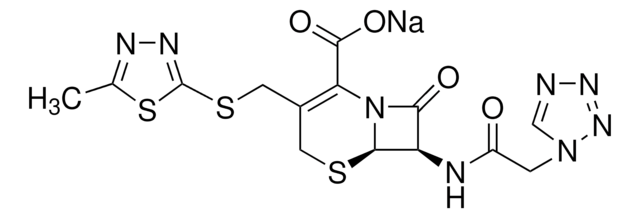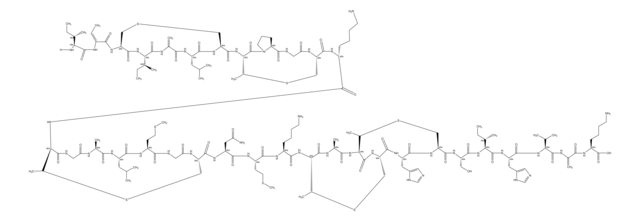P8692
Paromomycin sulfate salt
powder, suitable for plant cell culture, BioReagent
About This Item
Recommended Products
product name
Paromomycin sulfate salt, suitable for plant cell culture, BioReagent
product line
BioReagent
Quality Level
form
powder
technique(s)
cell culture | plant: suitable
antibiotic activity spectrum
Gram-negative bacteria
Gram-positive bacteria
application(s)
agriculture
Mode of action
protein synthesis | interferes
SMILES string
O[C@H]1[C@H](O)[C@@H](CO)O[C@H](O[C@@]2([H])[C@H](O[C@@]3([H])[C@H](O)[C@H](O[C@]4([H])[C@H](N)[C@@H](O)[C@H](O)[C@H](CN)O4)[C@@H](CO)O3)[C@@H](O)[C@H](N)C[C@@H]2N)[C@@H]1N.C
InChI
1S/C23H45N5O14.CH4/c24-2-7-13(32)15(34)10(27)21(37-7)41-19-9(4-30)39-23(17(19)36)42-20-12(31)5(25)1-6(26)18(20)40-22-11(28)16(35)14(33)8(3-29)38-22;/h5-23,29-36H,1-4,24-28H2;1H4/t5-,6+,7+,8-,9-,10-,11-,12+,13-,14-,15-,16-,17-,18-,19-,20-,21-,22-,23+;/m1./s1
InChI key
OYJABWUHUYVDMJ-UDXJMMFXSA-N
Looking for similar products? Visit Product Comparison Guide
General description
Application
Biochem/physiol Actions
Packaging
Other Notes
Storage Class Code
11 - Combustible Solids
WGK
WGK 3
Flash Point(F)
Not applicable
Flash Point(C)
Not applicable
Certificates of Analysis (COA)
Search for Certificates of Analysis (COA) by entering the products Lot/Batch Number. Lot and Batch Numbers can be found on a product’s label following the words ‘Lot’ or ‘Batch’.
Already Own This Product?
Find documentation for the products that you have recently purchased in the Document Library.
Customers Also Viewed
Articles
Antibiotic kill curve is a dose response experiment in which mammalian cells are subjected to increasing amounts of selection antibiotic
Antibiotic kill curve is a dose response experiment in which mammalian cells are subjected to increasing amounts of selection antibiotic
Antibiotic kill curve is a dose response experiment in which mammalian cells are subjected to increasing amounts of selection antibiotic
Antibiotic kill curve is a dose response experiment in which mammalian cells are subjected to increasing amounts of selection antibiotic
Our team of scientists has experience in all areas of research including Life Science, Material Science, Chemical Synthesis, Chromatography, Analytical and many others.
Contact Technical Service








